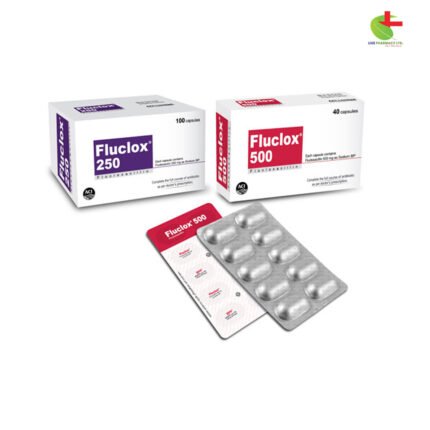Fluclox 500
140.00৳ Strip
- Flucloxi is a penicillinase-resistant antibiotic effective against Gram-positive bacterial infections.
- Treats skin and soft tissue infections, respiratory tract infections, and osteomyelitis.
- Specifically targets penicillinase-producing staphylococci.
- Used in both therapeutic and prophylactic settings, including major surgeries.
- Available in oral and injectable forms, with dosage adjustments for severity.
- Always use as directed by a healthcare provider.
 Brand
Brand
|
ACI Limited |
|---|---|
 Generics
Generics
|
Flucloxacillin Sodium |
 Type
Type
|
Capsule |
Indications
Flucloxi is a broad-spectrum antibiotic indicated for the treatment of infections caused by Gram-positive bacteria, including penicillinase-producing staphylococci. These include:
- Skin and Soft Tissue Infections: Boils, abscesses, carbuncles, infected skin conditions (ulcers, eczema, acne, furunculosis, cellulitis), infected wounds, burns, otitis media, impetigo, and more.
- Respiratory Infections: Pneumonia, lung abscess, empyema, sinusitis, pharyngitis, tonsillitis, and quinsy.
- Other Infections: Osteomyelitis, enteritis, endocarditis, urinary tract infections, meningitis, and septicemia caused by Flucloxi-sensitive organisms.
- Prophylaxis: Used during major surgeries, including cardiothoracic and orthopedic procedures, to prevent infection.
Use Flucloxi as prescribed by your healthcare professional.
Pharmacology
Flucloxacillin is a penicillinase-resistant penicillin effective against Gram-positive bacteria, including those producing penicillinase. It works by inhibiting bacterial cell wall synthesis, particularly targeting the transpeptidase enzyme which is essential for cross-linking peptidoglycan in the bacterial cell wall. This leads to cell wall weakness and bacterial cell rupture.
Flucloxacillin’s unique structure makes it resistant to penicillinase hydrolysis, ensuring its efficacy against penicillinase-producing staphylococci. It is a bactericidal antibiotic, with minimal activity against Gram-negative organisms.
Dosage
Oral Administration:
- Adults: 250 mg, 4 times daily. For severe infections, the dosage may be increased. In conditions like osteomyelitis and endocarditis, up to 8 g per day may be required.
- Children (2-10 years): Half of the adult dose.
- Children (under 2 years): A quarter of the adult dose.
Parenteral Administration (Injectable):
- Adults:
- Intramuscular: 250 mg, 4 times daily.
- Intravenous: 250 mg – 1 g, 4 times daily (via slow injection or infusion).
- For severe infections, up to 8 g per day may be used.
- Children:
- 2-10 years: Half of the adult dose.
- Under 2 years: A quarter of the adult dose.
Consult your doctor for exact dosage and duration based on your condition.
Administration
- Oral: Take Flucloxi 1 hour before meals.
Always follow the dosage instructions provided by your doctor.
Interactions
Using Flucloxi concurrently with certain medications may increase its blood levels for a prolonged period. Discuss all medications you are taking with your healthcare provider before using Flucloxi.
Contraindications
Flucloxacillin should not be used by patients who are allergic to penicillin or any of its components.
Side Effects
Common side effects may include:
- Gastrointestinal: Nausea, vomiting, diarrhea, and indigestion.
- Others: Rashes, urticaria, fever, purpura, interstitial nephritis, hepatitis, and cholestatic jaundice.
Pregnancy & Lactation
Flucloxacillin falls under US FDA Pregnancy Category B. It should only be used during pregnancy if necessary. This drug is excreted in human milk, so caution is advised when administering to breastfeeding mothers.
Precautions & Warnings
Flucloxi should be used with caution in patients with:
- Liver dysfunction.
- Allergic conditions.
Consult your doctor if you have any existing health conditions or are taking other medications.
Use in Special Populations
- Severe Renal Failure: Adjust dosage or extend the dose interval for patients with renal impairment.
- Geriatric Use: No significant safety or efficacy differences observed, but elderly patients may be more sensitive.
Storage
Store in a cool, dry place, away from direct light and heat. Keep out of the reach of children.













Reviews
There are no reviews yet.